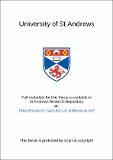Files in this item
Reproductive investment in the zebra finch, Taeniopygia guttata
Item metadata
| dc.contributor.advisor | Slater, P. J. B. (Peter James Bramwell), 1942- | en |
| dc.contributor.author | Rutstein, Alison N. | en |
| dc.coverage.spatial | 159 p : col. ill. 30 cm. | en |
| dc.date.accessioned | 2021-04-08T08:57:10Z | |
| dc.date.available | 2021-04-08T08:57:10Z | |
| dc.date.issued | 2003 | |
| dc.identifier.uri | https://hdl.handle.net/10023/21846 | |
| dc.description.abstract | Reproduction is costly; therefore females are predicted to allocate resources depending upon the perceived costs and benefits of a particular breeding attempt. Within a clutch, females are also predicted to invest in offspring according to their perceived fitness returns, which may depend upon their sex and position in the hatching sequence. This thesis examines female resource allocation in zebra finches, Taeniopygia guttata, in relation to changes in mate attractiveness and diet quality, with an emphasis on primary investment and differential sex allocation. Females that were given an attractive male as their first mate were found to lay heavier eggs than females that were given an unattractive male as their first mate, but there was no difference in offspring quality between treatments at any stage of development. There was also no evidence of differential sex allocation in either treatment. Diet quality had a stronger effect on resource allocation and reproductive success. Females on a high quality (HQ) diet laid heavier clutches and reared more and higher quality young than on a low quality (LQ) diet. This could have partly resulted from differences in egg size and quality. Eggs laid on the HQ diet were better provisioned with yolk and albumen and had higher concentrations of yolk androgens. In line with sex allocation theory, female-biased broods were produced on the HQ diet and male-biased broods on the LQ diet. There were also sex differences in androgen deposition between the diets, with greater concentrations of yolk androgens in male eggs on the LQ diet and female eggs on the HQ diet. Egg mass increased with position in the laying sequence on the HQ diet but not on the LQ diet, which affected within-brood patterns of post-hatching mortality. Yolk androgen and carotenoid concentrations, however, decreased with laying sequence on both diets. | en |
| dc.language.iso | en | en |
| dc.publisher | University of St Andrews | en |
| dc.subject.lcc | QL696.P244R8 | |
| dc.subject.lcsh | Zebra finch | en |
| dc.subject.lcsh | Birds--Reproduction | en |
| dc.title | Reproductive investment in the zebra finch, Taeniopygia guttata | en |
| dc.type | Thesis | en |
| dc.type.qualificationlevel | Doctoral | en |
| dc.type.qualificationname | PhD Doctor of Philosopy | en |
| dc.publisher.institution | The University of St Andrews | en |
This item appears in the following Collection(s)
Items in the St Andrews Research Repository are protected by copyright, with all rights reserved, unless otherwise indicated.

